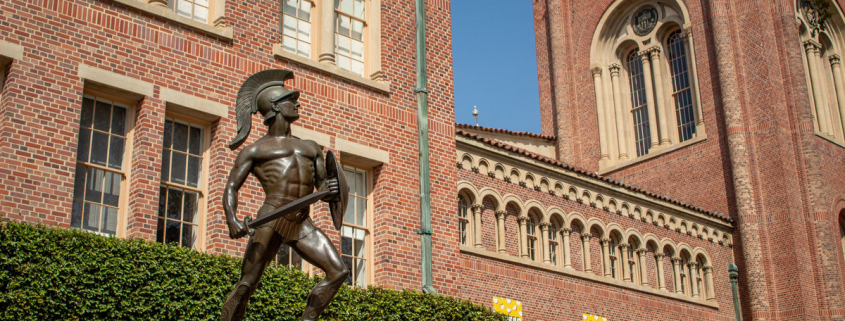Crosstown program trains prospective EMTs

Amid a national shortage of emergency medical technicians, a joint USC-UCLA program is offering students an opportunity to become certified emergency medical technicians.
EMTs provide crucial emergency medical care and transportation for people who become sick or injured, but those services are being strained: According to an American Ambulance Association study, more than half of part-time EMT positions in the United States remained unfilled in 2022.
In collaboration with Emergency Medical Services of USC, the hybrid program conducted by the UCLA Center for Prehospital Care trains USC students on the skills necessary to operate as EMTs and provide care during emergencies.
The program, which hosted 30 students during the fall session, began in 2019 after a chance meeting of UCLA and USC members during an EMS conference, said Michael Kaduce, director of EMT programs at UCLA. It has been drawing the interest of students each session over the past few years, he added.
Nima Nikravesh, a graduate student studying dental surgery at the Herman Ostrow School of Dentistry who completed the program, said becoming an EMT was a rigorous and fulfilling process.
Like many students, Nikravesh said he began the course as a way of gaining hands-on clinical practice before entering the field. During the course, Nikravesh learned about the fundamentals of emergency care, from conducting CPR to protecting patient airways.
“I was an 18-year-old student, and being able to learn stuff like performing life saving measures was incredible,” Nikravesh said.
The 10-week hybrid program consists of twice weekly online lectures, followed by a full day each week dedicated to in-person skills training at USC. The next session of the course, which begins in April, is now enrolling. After completing the EMT course, students become certified by taking a national licensing test called the NREMT Exam, Kaduce said.
Nikravesh said that working as an EMT offers a unique experience of treating a range of unique patients, from minor headaches to major trauma.
“Being able to see how that patient progressed and became so much better because of your care — it is a truly rewarding experience,” Nikravesh said.
The Emergency Medical Services of USC is a group for USC students who are EMTs to provide services on campus, said Christina Ferrero, director of EMSC and a senior majoring in human biology and healthcare studies. During on campus events, including the Welcome Back Concert and Springfest, EMSC members staff medical tents and respond to medical emergencies, Ferrero said.
EMSC also works to encourage the USC community to become familiar with emergency medical services, Ferrero said, providing training as well as opportunities to learn more about emergency medicine.
“The privilege of being able to provide these services to the USC community is a gift in and of itself,” Ferrero said. “That generally is the mission of our organization.”
In addition to the EMT certification program, EMSC offers CPR training courses open to USC community members, said Maia Dau, associate director and CPR coordinator for EMSC.
Dau, a senior majoring in biology, dance and Spanish, encouraged anyone with an interest in the field to go through the steps of becoming an EMT. Even if it does not end up being someone’s final career path, she said, the experience provides valuable lessons applicable beyond the field.
“It has really shaped the trajectory of my life,” Dau said. “It has opened a lot of different doors and possibilities for me, just in that it allows you to hone a lot of skills that you might not be able to practice otherwise.”
Dau said working with EMSC has helped prepare her for interacting with patients beyond a strictly clinical approach.
“We really emphasize treating everyone as humans and as humans first and foremost, before patients,” Dau said. “I’ve really learned how to best navigate tough circumstances.”
After joining the EMSC program, EMTs continue to refine their skills, said Nicholas Cortez, director of training for EMSC and a senior majoring in human biology. Members of the program consistently participate in scenarios that emulate situations they may encounter while responding to emergencies, Cortez said.
“No two calls are exactly the same,” Cortez said. “So learning that common sense of what gear to use when, and the small nuances between calls, are really important.”
The healthcare field, and EMTs in particular, have faced pressure during the coronavirus pandemic. Ferrero said that even though being an EMT comes with its challenges, the role allows for the development of new mindsets.
“Being exposed to people in their most vulnerable moments – I think that’s something that really can transform a person,” Ferrero said. “It’s important to be cognizant of that and welcome those changes, because they can be really beautiful changes if you allow them to happen.”

